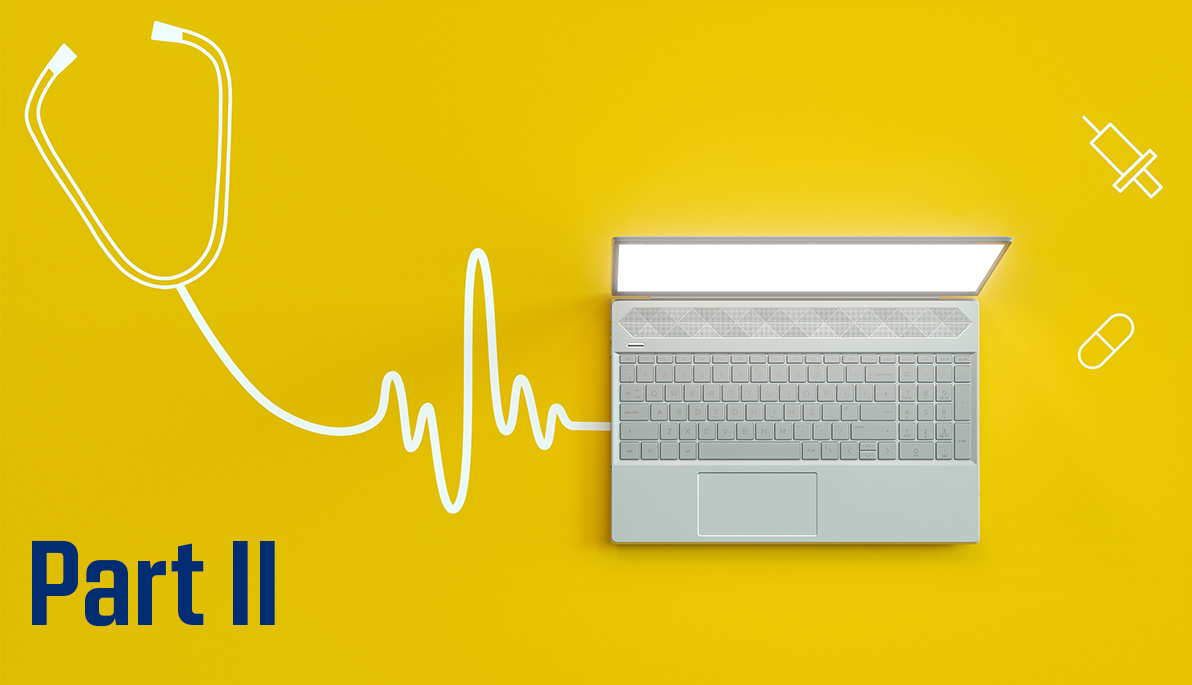News
Faculty Forum: Telemedicine Matures During the Pandemic
May 10, 2022
We welcome faculty-generated content to spotlight our university’s rich array of expertise. Part II of the series from School of Health Professions Associate Professor of Physician Assistant Studies Shinu Kuriakose focuses on the challenges and opportunities of telemedicine, as well as acceptance and hurdles that need to be overcome.
COVID-19 has highlighted disparities in how care is accessed. As the costs associated with medical care, especially in the United States, keep increasing, telemedicine is a field where effective diagnosis and treatment coupled with cost-effective economics can lead to positive health outcomes.
Among the biggest advantages of using telemedicine is that clinicians can see patients relatively soon without considering geographical barriers and time constraints. Telemedicine also mitigates costs associated with needing a physical space to see patients and allows patients to find clinicians who speak their language without needing an interpreter present. In fact, a comprehensive study in a California institution utilizing telemedicine demonstrated that “a higher proportion of the telemedicine appointments was kept, telemedicine appointments were significantly less likely to be canceled by patients, and significantly less likely to be no-shows.” At the same time, the results of a pilot program focused on rural areas of North Carolina where patients with medical problems were evaluated via telemedicine demonstrate that they experienced shorter hospital stays and yielded savings of $1,500 per patient who were also more likely to follow up for aftercare.
Additionally, the cost-effectiveness of telemedicine was a boon to financially strained community health centers since patients could be screened at a distance for admissions and treatment without weather or other “acts of God” playing a tangible part in preventing treatment. When used by seasoned professionals, telemedicine has also demonstrated success in instances where children need to be evaluated by health clinicians, and there has not been any difference in healthcare outcomes noted between traditional medical adolescent screening and electronic screening.
Overcoming Barriers
Despite the positive aspects this technology offers, there are barriers that need to be overcome. For example, it can be difficult to assess patients’ body language, especially if they are not forthcoming regarding medical issues, and the technology curtails personal contact with patients, which can impact trust between provider and patient. There is also concern that utilizing telemedicine in institutions where there is insufficient clinician training and feedback can lead to lower morale due to less patient interaction. Furthermore, telemedicine remains dependent on a robust electronic communication system for thorough vocal and visual cues, which can be expensive to maintain, and orientating to this technology requires time and financial resources when starting a program.
Importantly, to use telemedicine as a treatment modality, clinicians must become familiar with the electronic medical record platform. As such, training is required to ensure they can harness their capabilities to serve patients adequately.
There continues to be some clinician reluctance who overall do see telemedicine as a positive tool for patient care. A study in 2018 found that although 90 percent of physicians surveyed felt telemedicine was valuable in inpatient care, only 14 percent utilized this medium. The reluctance primarily stemmed from the cost associated with purchasing telemedicine infrastructure, lack of knowledge regarding the legalities of telemedicine, especially in the context of the Health Insurance Portability and Accountability Act (HIPAA), doubts on whether patients would accept the modality, and concerns about compensation both from private and public entities. Patients have also expressed concerns about the confidentiality of telemedicine. Finally, there continue to be concerns about HIPAA violations due to fears of hacking.
Economics Play a Role, Too
The shift from traditional office and hospital-based medicine to increasingly utilizing electronic means for health evaluations, screening, and treatment also has potential financial benefits. It can be cost-effective for clinicians to see patients without the costs involved in commuting to physical locations where patients live and without needing to maintain an office and employ staff and a roster of specialists. Telemedicine also can reduce costs for patients by eliminating travel and minimizing work disruption and can provide easier access for patients with disabilities to be evaluated by clinicians without needing specialized vehicles for travel reasons.
Ongoing Acceptance as Telemedicine Matures
Certainly, there continue to be hiccups such as regulatory issues, reimbursement, patient education, provider familiarity, and integration in both the medical community and society. The adversity inherent in COVID-19 has allowed an opportunity for telehealth to mature and be viewed as a viable, economical, and patient-friendly option.
If you are interested in contributing a Faculty Forum piece, email box@nyit.edu.


_Thumb.jpg)

